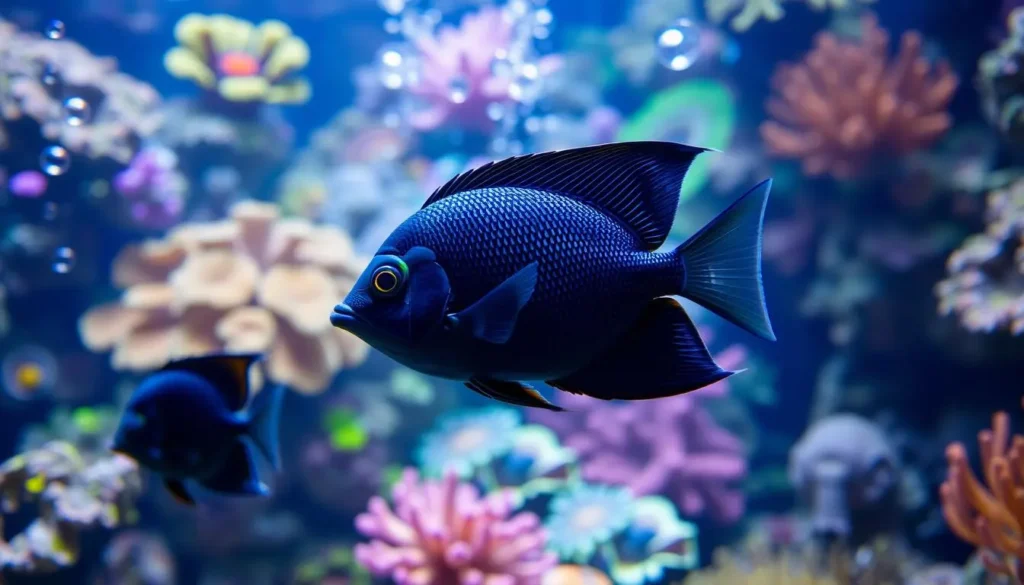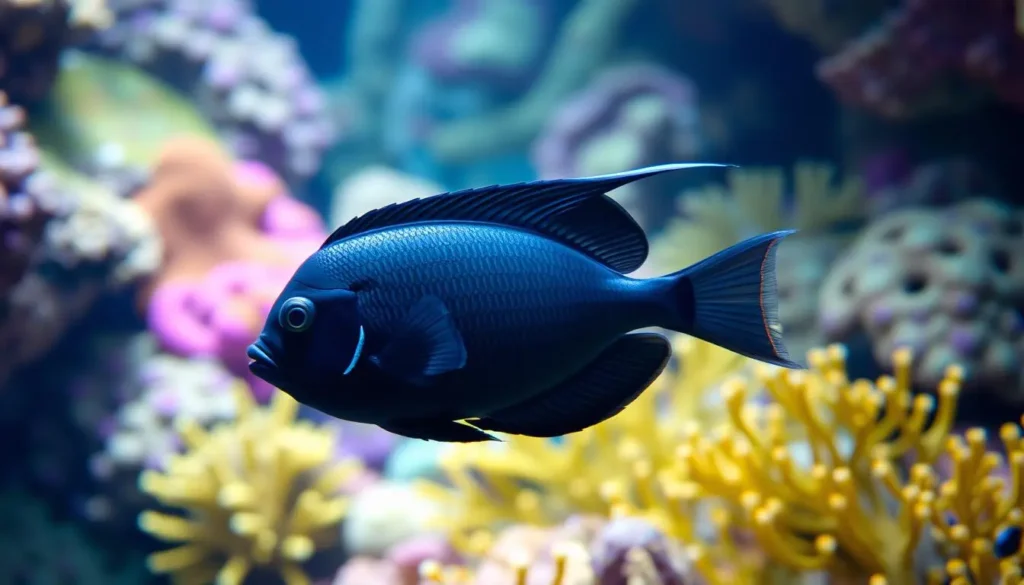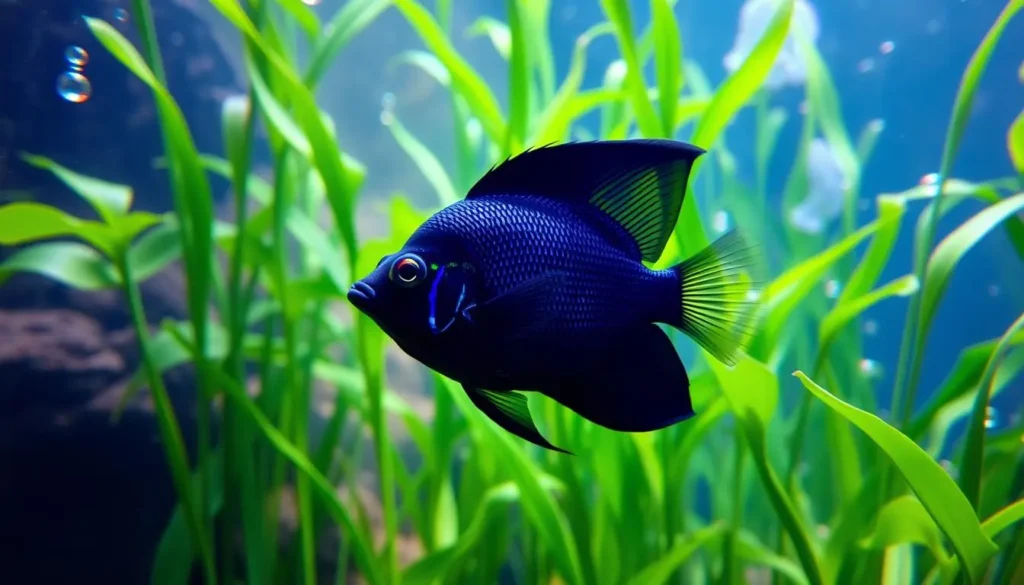Table of Contents
Step into the captivating world of black angelfish. These stunning freshwater fish can make any aquarium beautiful. With their unique black and white colors, they are a favorite among aquarium lovers. They are known for their graceful movements and striking looks.
In this guide, we’ll dive into their origins, care needs, breeding, and popular varieties. This will help you decide if black angelfish are right for your home aquarium.

Key Takeaways
- Black angelfish are a stunning and elegant freshwater fish species with a distinctive black and white coloration.
- They are known for their graceful movements and captivating appearance, making them a popular choice among aquarium enthusiasts.
- This guide covers the origins, care requirements, breeding techniques, and popular varieties of black angelfish to help you decide if they are the right fit for your home aquarium.
- Proper tank setup, water parameters, and compatible tankmates are crucial for the successful care of black angelfish.
- Understanding the unique characteristics and needs of black angelfish is essential for providing them with a thriving environment in your home aquarium.
Introducing the Captivating Black Angelfish
Get ready to fall in love with the black angelfish. These stunning fish have won the hearts of many aquarium fans. Each one comes from a different place, adding to their charm and making them a favorite in homes.
Origins and Natural Habitat
The black angelfish, or Pterophyllum scalare, come from the Amazon River in South America. They love the slow, green waters of the Amazon, Orinoco, and Essequibo rivers. Their home is full of plants, giving them places to hide and feel safe.
Distinctive Appearance and Coloration
The black angelfish stand out with their special look. Their bodies are shaped in a way that’s both unique and beautiful. They can be solid black or have fancy patterns that look like black lace. Some even have a cool black and white design.
| Angelfish Variety | Color Pattern | Unique Features |
|---|---|---|
| Black Lace Angelfish | Intricate black lace-like patterns | Highly sought-after for their stunning appearance |
| Black Veil Angelfish | Solid black coloration with elongated fins | Elegant and regal-looking |

The black angelfish are a wonder to see in any tank. Their colors and shapes are amazing. They come from different places, making them even more special in the world of fish.
Caring for Your Black Angelfish
Keeping the right tank setup and water conditions is key for your black angelfish’s health. These beautiful fish need a special environment to do well in your aquarium.
Tank Setup and Water Parameters
For your black angelfish, make sure they have enough room to swim. They can get quite big, so a 55-gallon tank is a good start. Your tank should also have good filters, air, and places to hide, like plants and decorations.
Water quality is very important for black angelfish. Keep the water between 75°F and 82°F, and the pH between 6.8 and 7.8. Change 25% to 30% of the water regularly to keep it clean. This helps prevent stress and sickness in your black angelfish.
| Parameter | Ideal Range |
|---|---|
| Temperature | 75°F – 82°F |
| pH | 6.8 – 7.8 |
| Ammonia | 0 ppm |
| Nitrite | 0 ppm |
| Nitrate |
By giving your black angelfish the best tank and water, you’ll help them live their best lives in your aquarium.

Compatibility and Tankmates
Choosing the right tankmates is key when you have black angelfish in your aquarium. These elegant fish do well in calm community tanks. But, picking the right species to keep with them is important.
Peaceful Community Tanks
Black angelfish are usually calm and fit well in community aquariums. They prefer to be with other slow-moving fish that need similar care. Good tankmates for black angelfish include:
- Tetras
- Corydoras catfish
- Dwarf cichlids
- Rasboras
- Mollies
Species-Specific Considerations
Even though black angelfish are generally calm, they can get territorial. They might defend their space when breeding. It’s best to keep them away from aggressive, fast fish that could harm them. Some fish to avoid include:
- Barbs
- Larger cichlids
- Bala sharks
- Tinfoil barbs
Also, make sure your tank is big enough. It should fit the black angelfish’s full size and the number of tankmates. With the right tankmates and a big, clean aquarium, your black angelfish will do great. They’ll show off their beautiful black and white colors.
Feeding Your Black Angelfish
It’s important to feed your black angelfish a balanced diet. This keeps them healthy and full of life. They need specific foods to stay well.
Feeding them a variety of foods is best. They like flakes, pellets, frozen, and freeze-dried foods. Live foods like brine shrimp and bloodworms are also good. They add important nutrients and make mealtime exciting.
Here are some tips for feeding your black angelfish:
- Feed them high-quality flakes or pellets made for angelfish or tropical fish.
- Add frozen or freeze-dried foods like brine shrimp, bloodworms, or daphnia a few times a week.
- Give them live foods like brine shrimp or blackworms sometimes. It’s good for them and fun.
- Don’t overfeed. This can harm their health. Feed them small amounts several times a day.
By following these tips, you can keep your black angelfish healthy and happy. A well-fed black angelfish is a beautiful sight in your aquarium.
“A well-fed black angelfish is a truly magnificent sight to behold in the aquarium.”
Breeding Black Angelfish
Exploring the art of breeding black angelfish is a thrilling adventure for aquarium lovers. It involves setting up the perfect spawning conditions and raising the fry. This journey demands a keen eye for detail and a solid grasp of these fish’s special needs.
Preparing for Spawning
To encourage breeding, create a suitable environment for your black angelfish. Start by preparing a breeding tank with clean, oxygen-rich water and a soft flow. Add plants and driftwood for hiding spots, making the fish feel safe and at ease.
Warm the water to 82-86°F (28-30°C) and keep the pH between 6.8 and 7.2. Regular water changes can also help simulate natural conditions that prompt spawning.
Raising Fry and Juveniles
- After spawning, the eggs will hatch in 2-3 days, depending on the temperature.
- The fry need a diet of liquid fry food, crushed flakes, or brine shrimp to grow fast.
- Keep a close eye on water quality and change it often to ensure the fry thrive.
- As the juveniles grow, introduce them to a varied diet and larger tank mates for a smooth transition.
With patience, careful attention, and a deep understanding of black angelfish breeding, you can successfully raise healthy, vibrant juveniles.
Popular Black Angelfish Varieties
Explore the wide range of black angelfish varieties. Each has its own special traits and charm. Learn about the black lace angelfish and black veil angelfish. See how they can make your aquarium even more beautiful.
Black Lace Angelfish
The black lace angelfish is a stunning variety. It has a mix of black and white colors. Its fins look like lace, creating a beautiful sight.
These fish swim gracefully and are very calm. They are a favorite for community tanks.
Black Veil Angelfish
The black veil angelfish is perfect for adding elegance to your tank. It has flowing fins that look like veils. This makes it look very regal.
The black and white colors stand out even more with its beautiful movements. It’s loved by both new and experienced fish keepers.
Whether you love the lace patterns or the flowing fins, these black angelfish will impress. They add a touch of elegance to your saltwater angelfish black and white tank.
black angelfish and Aquascaping
The black angelfish is a stunning addition to any aquarium. Its elegant look can fit well with many aquascaping styles. By learning about aquascaping, you can make tanks that show off these fish’s beauty.
For aquascaping with black angelfish, aim for a balance between the fish and their home. Black angelfish love environments that remind them of their natural river homes, with lots of plants, driftwood, and rocks. This way, you can make spaces that look great and are good for your fish.
The Dutch-style layout is great for black angelfish. It uses tall plants to add depth and interest. By arranging plants carefully, you can create a beautiful underwater garden that highlights the black angelfish.
The Iwagumi style is also good for black angelfish. It focuses on stones and simple plants. This style lets the fish be the main attraction, making them the center of the tank.
No matter the style, the goal is to balance the black angelfish with their surroundings. By adding elements that remind them of their natural home, you can make aquariums that are both beautiful and healthy for these fish.
Common Health Issues and Prevention
Black angelfish are stunning, but they face health concerns that need careful attention. Knowing the common diseases they get is key to keeping them healthy and long-lived in your tank.
Identifying and Treating Diseases
Ich is a big problem for black angelfish. It shows up as white spots on their body and fins. If not treated, it can be deadly. But, it can be cured with salt, temperature changes, and the right medicine.
Fin rot is another issue. It’s a bacterial infection that makes fins fall apart. It’s often caused by bad water, stress, or injury. Quick treatment with antibiotics and fixing the water can help fix fin rot.
- Parasitic infections like Ich
- Bacterial infections such as fin rot
- Nutritional deficiencies leading to stunted growth or deformities
- Stress-induced illnesses due to improper tank conditions
Spotting disease early and treating it fast is vital for your black angelfish. Regular water checks, keeping water quality right, and a stress-free tank can prevent many health problems.
By being watchful and taking steps ahead of time, you can help your black angelfish stay healthy. They’ll keep your tank beautiful with their grace.
Conclusion
Black angelfish are amazing additions to any home aquarium. Their elegant looks, mesmerizing colors, and calm nature make them a joy to watch and care for. Knowing how to care for them ensures they thrive and show off their beauty.
Adding black angelfish to your aquarium can make it more beautiful and peaceful. They are perfect for both experienced and new aquarium owners. With the right setup and care, they will add elegance to your underwater world.
When you start with black angelfish, keep an eye on their health. Fix any problems quickly and create a space that meets their needs. This way, you’ll enjoy their stunning presence and add natural beauty to your home.
FAQ
What is the natural habitat of black angelfish?
Black angelfish come from tropical South American rivers. This includes the Amazon and Orinoco basins. They love slow, oxygen-rich waters with lots of plants and driftwood.
How can I identify a black angelfish?
You can spot black angelfish by their unique colors. They can be solid black or have white or yellow spots. They have a tall body and beautiful fins.
What are the ideal water parameters for keeping black angelfish?
Black angelfish need warm, soft, and slightly acidic water. The best temperature is 75-82°F. The pH should be 6.0-7.5, and the water hardness should be moderate.
What types of tankmates are best for black angelfish?
Black angelfish are calm and can live with other peaceful fish. Good tankmates include tetras, corydoras, and other angelfish. Avoid aggressive fish that might stress them out.
How often should I feed my black angelfish?
Feed your black angelfish a mix of flakes, pellets, and frozen foods. Give them small meals 2-3 times a day. This keeps them healthy and happy.
Can I breed black angelfish in my home aquarium?
Yes, you can breed black angelfish at home. Make sure the water is right, and provide hiding spots and a spawning medium. This helps them pair up and breed successfully.
What are some popular black angelfish varieties?
Popular varieties include the black lace angelfish and the black veil angelfish. The lace angelfish has detailed patterns, and the veil angelfish has long fins and striking colors.
How can I incorporate black angelfish into my aquascaping design?
Black angelfish add elegance to any aquascape. Their fins look great with plants or in simple setups with driftwood. They fit well in many styles.
What are common health issues that affect black angelfish?
Black angelfish can get sick with ich, fin rot, and bacterial infections. Keep the water clean, feed them well, and reduce stress. This helps prevent and treat these diseases.